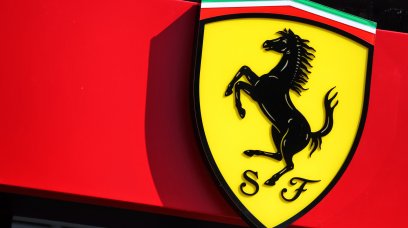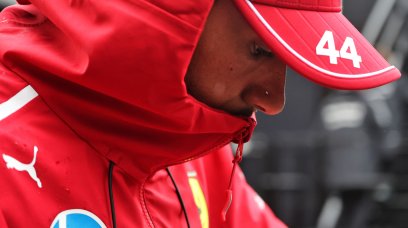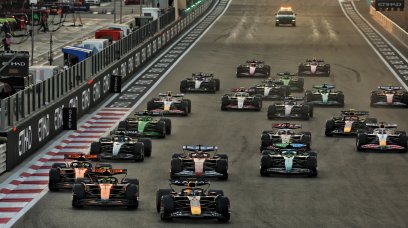The first thing that immediately struck me about the new F1 Exhibition in Madrid is how conveniently located the venue is. Based in the IFEMA complex, the hall is just a handful of stops away from Madrid Barajas airport on the metro system – handy if you plan on catching the underground into the city centre. The nearest station, Feria de Madrid, is not even a five-minute walk away, and I'd have gotten there even quicker if I took the right exit... If you do arrive straight from the airport, then there are lockers to store your luggage while you experience the new exhibition, which scouted locations all over the continent before settling, for now, in the Spanish capital. It was in the days after the Australian Grand Prix when I visited and so I decided to observe the crowd waiting to collect their audioguides. Demographically, there was a 50-50 split between male and female, with a lot of families around, some sporting team gear. There was an awful lot of green Aston Martin merch, whose wearers must all love it when el plan comes together...
Something for everyone
Your audioguide can be used to zap 'points of interest' on items for an explanation of what they are and how they are important. This is not so necessary in the opening section, which features a series of video screens playing clips on a loop of standout moments from decades of racing, and even those before the World Championship was incepted in 1950. Moving along, you enter the 'Design Lab', featuring Pierre Gasly's winning AlphaTauri machine from the 2020 Italian Grand Prix in pride of place. Also on display here are a Mercedes power unit, transmissions, gearboxes and other technical equipment – although it is the big car in the middle which seems to draw the most attention... This room is also light and airy, almost like a lab in many ways, and is in stark contrast to what comes next.
Grosjean's chassis is sobering
Nothing can prepare you for the sheer scale of destruction that is the wreck of Romain Grsojean's Haas chassis from his fiery 2020 accident in Bahrain. Take what you think the chassis looks like and times it by 100, and then maybe a little more. And sitting there, proud and strong amid this carnage, is the Halo which saved his life that November night. Unlike the bustle of the 'Design Lab', it is quiet in here, almost serene as people inspect, reinspect and then – as if they can't quite believe a human being got out of this alive – go back in for a another view. It is respectful as well, as children who were running around previously seem to notice the gravitas of what is sitting in front of them and a hush descends. The room is black, aside from the video screen showing clips from Bahrain, and it feels like a vacuum in here. It feels a room unlike any other in the entire exhibition, a room unto itself. Credit must go to Haas for wanting the chassis to go on display and not simply destroying it. It will stand the test of time as a monument to the safety of Formula 1.
Helmets and GOATs
After leaving the 'Survival' area, you head into an space dedicated to the drivers, where the bustle begins to pick back up. Numerous trophies and racing gear from the current field are on display, with Lewis Hamilton's old kart drawing a few wondering eyes, especially from the younger children. In the middle of the room is a display of drivers through the ages – from Carlos Sainz way back to the 1920s, all decked out in the appropriate gear of their era. It truly is remarkable how things have evolved from goggles and skull caps. As you move through, nearly 100 helmets from drivers including Ayrton Senna, Michael Schumacher, Max Verstappen and Hamilton are on display, a majority of which are original. I did try and count them all, but alas kept losing track as I glanced upon this helmet or that. The exhibition also gives fans a chance to rank their top 10 drivers of all time, with an interactive leaderboard being updated with running scores. It is an extremely neat feature. I did not add to it myself, although would have ranked Sir Jackie Stewart as F1's GOAT, but that's a debate for another day...
Pièce de résistance
The finale is an immersive experience, as if you were on the pit wall during a race. There are strobe lighting effects as the room turns into a virtual pit wall, with data flying about as it takes you through each stage of a Grand Prix, from calling strategy to spraying the bubbly at the end, if you're so lucky. In total, I spent about an hour and a half visiting the exhibition, with the flow through being quick with very few bottlenecks, if any, throughout my visit. It will be at IFEMA in Madrid until early June before moving on, with the possibility of it arriving somewhere else not being ruled out, although nothing concrete is in place at the time of writing. And with that, it was off to the city centre of Madrid, with the underground line terminating in the centre a short walk away from Real Madrid's Santiago Bernabeu stadium. A visit to the F1 Exhibition in Madrid is a must for any fan, old or new to Grand Prix racing. The rich assortment of artefacts and exhibits on display make it an engaging, immersive and sobering experience, one that raises the question of why nothing like this has been set up before?
Most read






